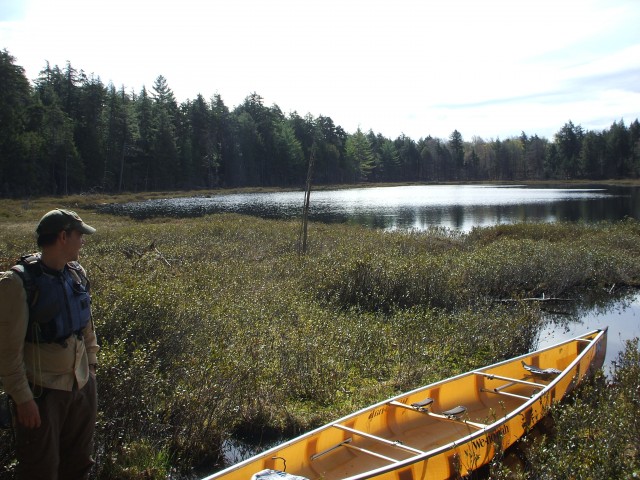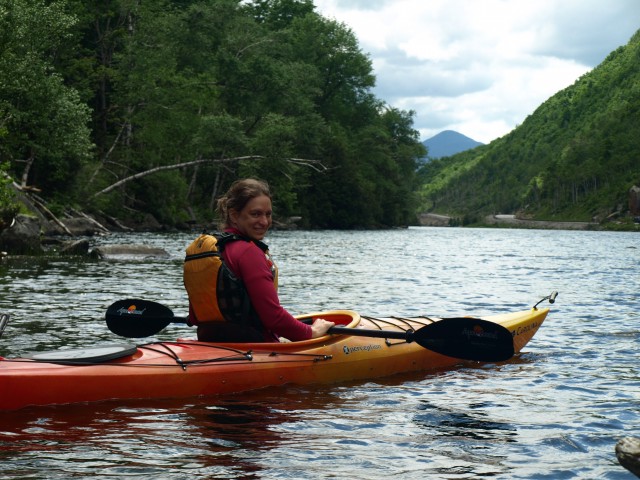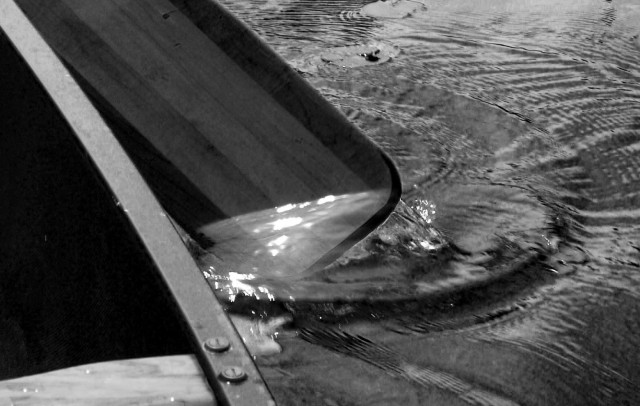Cold water paddling, preparation & fun
I might be a little on the early side for talking about cold water paddling, but it’s better to get the thoughts rolling early so you can plan ahead and be ready when the time comes. I hated to put my paddle away for the season but I did stretch it out for as long as I felt comfortable doing so, and now it’s time to dust off the old canoe and get ready. Another thought is, trout season is opening and like some of you, I want to get out in my boat and cast a few lines in Lake Colby.
In short, we need to be a bit more conscious of how we pursue this activity in the spring of the year. We can’t go running out to the river in our flowered shorts and flip flops with three layers of sun screen on and expect to be OK – well, some might be able too, but I still don’t recommend this method of breaking into the season. Think about it, every day the ice is off the water it’s getting warmer, but that is a very slow process with the runoff from the snow-capped peaks. It’s not like the fall of the year which slowly creeps up on boat retirement, but a slow movement in the other direction. However, with the proper head on your shoulders, consciousness of safety and the proper gear, there’s no reason we can’t get a bit of an earlier start on the season.

The Adirondacks are HUGE
So for those of you reading this that might be new to the Adirondack Region here is a bit of a quick overview. The Adirondack Park is over 6,000,000 acres in size broken up between public (state) and private land. Within those 6-million acres is over 2,300 ponds and lakes, 1,500 miles of rivers and well over 30,000 miles of streams and brooks. However, not all of which can be paddled due to many factors, such as lack of an access point, private property and/or not sufficient enough water to support boat travel. With that beginning, there are numerous options in the Saranac Lake Region for paddling opportunities.
Paddling the Adirondacks is not only one of the most enjoyable outdoor activities in the park but it offers unique views into the lives of all species of wildlife and in the spring of the year, all walks of life are starting to rustle and come out of a state of rest. Some looking for food, some to stretch tight muscles, some to feel the warmth of the sun and some introduce new life to the region. Spring flowers will start to bloom before you know it and the moist smell of leaves will be in the air. Now that the winter has come and passed, the cold temperatures will start to move in the opposite direction and snow will start to drip from the rock cliffs and fill the waterways we love to enjoy.

Life Jacket
Spring paddling is a very important part of the Adirondacks and should be experienced by all, but this definitely is no time to skimp on the gear and the preparation. The personal flotation device (PFD) or life vest is as important now as it ever was, but even more so when the exposure to cold water can affect our abilities to swim and tread water. A PFD should be worn at all times. When selecting which one to wear, make sure it is sized correctly and fitted to your body securely. A type III PFD, certified by the USCG is highly recommended.
Get the gear
Be sure to consider the type of water you will be exploring. Big lakes that are less sheltered with trees tend to have bigger waves and are much harder to navigate. Adirondack lakes and ponds tend to be very shallow in areas which create more waves than deeper bodies of water so a change in weather patterns can affect them rather quickly and change your days paddling experience. With bigger waves come splashing, this is where a spray skirt with proper cold water gear becomes important. Rivers have a stronger current which can cause your boat to react differently. Be cautious of rapids and waterfalls when paddling rivers. In short, have a map and compass and know about the water you will be paddling. In the spring the same river you paddled in the fall or summer is very different. Current is changed by deeper waters, rocks are submerged and not seen, and eddies are stronger. With all bodies of water in the spring of the year, you should be aware of floating debris. Lakes might have logs floating or pieces of docks. Rivers can have large pieces of the forest floating downstream with you or at you and can at times build up a blockage in the river, creating what they call strainers.

A Float Plan
A float plan is very important. This is simply a piece of paper with your plan for the day and route so that someone can locate you, just in case something happens. A float plan can be left in your car even, but better off with someone like a family member. With the float plan you should have the appropriate gear for your trip. The proper gear would include map and compass and/or GPS, spray skirt, dry bags and even the use of a wet or dry suit or even just some neoprene layers. The neoprene not only acts as a wet suit and helps keep you warm, even when wet, but also adds a layer of flotation. There is much more paddling gear out that you should consider having. At least one person in your group should have a paddle float, a throw bag, a bilge pump and a first aid kit. Food and water are also very important in cold weather to keep up morale, energy and body warmth.
If you have never paddled before and feel uncomfortable doing so for the first time, especially in cold water conditions, we encourage you to take a lesson from a local guide service. Many guide services will offer a 2 to 4 hour introductory course for a very reasonable price.
I could probably talk for pages on paddling but I think it’s important for newcomers to the sport to realize the joys and the warnings about cold water paddling. The most important piece of gear you have is on you at all times, your head. Think straight, calm, cautiously and think ahead with good planning and you are more than half way there already.






